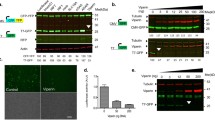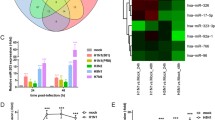Abstract
Previously, we described that acetylsalicylic acid (ASA) decreases HCV expression, but the mechanisms involved have not been clearly established. We evaluated the participation of inducible nitric oxide synthase (iNOS) in the regulation of HCV-RNA induced by ASA. Huh7 cells expressing non-structural HCV proteins were exposed to 4 mM ASA and incubated at the same times we reported HCV downregulation (24-72 h), and iNOS mRNA and protein levels were then measured by real-time PCR and Western blot, respectively. Nitric oxide levels were measured at the same time. Inhibition of iNOS mRNA by small interfering RNAs (siRNA) and activation of the iNOS gene promoter by ASA treatment were evaluated. In Huh7 replicon cells treated with ASA, we found decreased levels of iNOS mRNA, iNOS protein and nitrosylated protein levels at 48-72 h. ASA exposure also reduced the transactivation of the iNOS promoter in HCV replicon cells at 48 h, and this was partly due to the decrease in the affinity of transcription factor C/EBP-β for its binding site in the iNOS promoter. siRNA silencing of iNOS decreased HCV-RNA expression (65 %) and potentiated the antiviral effect (80 %) of ASA compared with control cells. ASA reduces iNOS expression by downregulating promoter activity, mRNA and protein levels at the same time that it decreases HCV expression. These findings suggest that the antiviral activity of ASA is mediated partially through the modulation of iNOS.




Similar content being viewed by others
Abbreviations
- ASA:
-
Acetylsalicylic acid
- HCV:
-
Hepatitis C virus
- iNOS:
-
Inducible nitric oxide synthase
- NO:
-
Nitric oxide
- NSAIDs:
-
Nonsteroidal anti-inflammatory drugs
- RT-PCR:
-
Reverse transcription polymerase chain reaction
References
Lok A, Seeff L, Morgan T et al (2009) Incidence of hepatocellular carcinoma and associated risk factors in hepatitis C-related advanced liver disease. Gastroenterology 136(1):138–148
Bartenschlager R, Frese M, Pietschmann T (2004) Novel insights into hepatitis C virus replication and persistence. Adv Virus Res 63(1):71–180
Appel N, Schaller T, Penin F et al (2006) From structure to function: new insights into hepatitis C virus RNA replication. J Biol Chem 281(15):9833–9836
Kagawa T, Keeffe E, Yu M et al (2010) Pegylated interferon and ribavirin treatment for hepatitis C virus infection. Hepat Res Treat 2010:275274
Hoofnagle J, Seeff L (2006) Peginterferon and ribavirin for chronic hepatitis C. N Engl J Med 355(23):2444–2451
Modi A, Hoofnagle J (2007) New therapies for hepatitis C. Hepatology 46(3):615–617
Garcia-Mediavilla M, Sanchez-Campos S, Gonzalez-Perez P et al (2005) Differential contribution of hepatitis C virus NS5A and core proteins to the induction of oxidative and nitrosative stress in human hepatocyte-derived cells. J Hepatol 43(4):606–613
Majano P, Garcia-Monzon C (2003) Does nitric oxide play a pathogenic role in hepatitis C virus infection? Cell Death Differ 10(Suppl 1):S13–S15
Vine C, Cole J (2011) Nitrosative stress in Escherichia coli: reduction of nitric oxide. Biochem Soc Trans 39(1):213–215
Mello E, Ribeiro S, Carvalho A et al (2011) Antifungal activity of PvD1 defensin involves plasma membrane permeabilization, inhibition of medium acidification, and induction of ROS in fungi cells. Curr Microbiol 62(4):1209–1217
Machida K, Cheng K, Sung V et al (2004) Hepatitis C virus infection activates the immunologic (type II) isoform of nitric oxide synthase and thereby enhances DNA damage and mutations of cellular genes. J Virol 78(16):8835–8843
Pautz A, Art J, Hahn S et al (2010) Regulation of the expression of inducible nitric oxide synthase. Nitric Oxide 23(2):75–93
Garcia-Monzon C, Majano P, Zubia I et al (2000) Intrahepatic accumulation of nitrotyrosine in chronic viral hepatitis is associated with histological severity of liver disease. J Hepatol 32(2):331–338
Mihm S, Fayyazi A, Ramadori G (1997) Hepatic expression of inducible nitric oxide synthase transcripts in chronic hepatitis C virus infection: relation to hepatic viral load and liver injury. Hepatology 26(2):451–458
Trujillo-Murillo K, Rincon-Sanchez A, Martinez-Rodriguez H et al (2008) Acetylsalicylic acid inhibits hepatitis C virus RNA and protein expression through cyclooxygenase 2 signaling pathways. Hepatology 47(5):1462–1472
Rivas-Estilla AM, Bryan-Marrugo OL, Trujillo-Murillo K et al (2012) Cu/Zn superoxide dismutase (SOD1) induction is implicated in the antioxidative and antiviral activity of acetylsalicylic acid in HCV-expressing cells. Am J Physiol Gastrointest Liver Physiol 302(11):G1264–G1273
Rivas-Estilla A, Svitkin Y, Lopez-Lastra M et al (2002) PKR-dependent mechanisms of gene expression from a subgenomic hepatitis C virus clone. J Virol 76(21):10637–10653
Trujillo-Murillo K, Alvarez-Martinez O et al (2007) Additive effect of ethanol and HCV subgenomic replicon expression on COX-2 protein levels and activity. J Viral Hepat 14(9):608–617
Cieslik K, Zhu Y, Wu K et al (2002) Salicylate suppresses macrophage nitric-oxide synthase-2 and cyclo-oxygenase-2 expression by inhibiting CCAAT/enhancer-binding protein-beta binding via a common signaling pathway. J Biol Chem 277(51):49304–49310
Akaike T, Maeda H (2000) Nitric oxide and virus infection. Immunology 101(1):300–308
Zhuang J, Lin C, Lin D et al (1998) Mutagenesis associated with nitric oxide production in macrophages. Proc Natl Acad Sci USA 95(14):8286–8291
Gilroy D (2005) New insights into the anti-inflammatory actions of aspirin-induction of nitric oxide through the generation of epi-lipoxins. Mem Inst Oswaldo Cruz 100(Suppl 1):49–54
Zaragoza C, Ocampo C et al (1997) Nitric oxide inhibition of coxsackievirus replication in vitro. J Clin Invest 100(7):1760–1767
Zaragoza C, Ocampo C, Saura M et al (1998) The role of inducible nitric oxide synthase in the host response to Coxsackievirus myocarditis. Proc Natl Acad Sci USA 95(5):2469–2474
Mannick J, Asano K et al (1994) Nitric oxide produced by human B lymphocytes inhibits apoptosis and Epstein-Barr virus reactivation. Cell 79(7):1137–1146
Croen K (1993) Evidence for antiviral effect of nitric oxide. Inhibition of herpes simplex virus type 1 replication. J Clin Invest 91(6):2446–2452
Akaike T, Maeda H (2000) Nitric oxide and virus infection. Immunology 101(3):300–308
Taylor B, de Vera M, Ganster R et al (1998) Multiple NF-kappaB enhancer elements regulate cytokine induction of the human inducible nitric oxide synthase gene. J Biol Chem 273(24):15148–15156
Wu K (2003) Control of COX-2 and iNOS gene expressions by aspirin and salicylate. Thromb Res 110(5–6):273–276
Ganster R, Taylor B, Shao L et al (2001) Complex regulation of human inducible nitric oxide synthase gene transcription by Stat 1 and NF-kappa B. Proc Natl Acad Sci USA 98(15):8638–8643
de Lucas S, Bartolome J, Amaro M et al (2003) Hepatitis C virus core protein transactivates the inducible nitric oxide synthase promoter via NF-kappaB activation. Antiviral Res 60(2):117–124
Frese M, Schwarzle V, Barth K et al (2002) Interferon-gamma inhibits replication of subgenomic and genomic hepatitis C virus RNAs. Hepatology 35(3):694–703
Kato N, Yoshida H, Ono-Nita S et al (2000) Activation of intracellular signaling by hepatitis B and C viruses: C-viral core is the most potent signal inducer. Hepatology 32(2):169–173
Acknowledgments
We thank Sergio Lozano-Rodriguez, M.D. (UANL) for his assistance in reviewing the manuscript. Financial support was provided by the CONACYT, grant number SALUD-2008-C01-86996, BASICA-CB2010-01-155082 and INFR-224638 awarded to AM Rivas.
Conflict of interest
No personal interest to declare.
Author information
Authors and Affiliations
Corresponding author
Rights and permissions
About this article
Cite this article
Ríos-Ibarra, C.P., Lozano-Sepulveda, S., Muñoz-Espinosa, L. et al. Downregulation of inducible nitric oxide synthase (iNOS) expression is implicated in the antiviral activity of acetylsalicylic acid in HCV-expressing cells. Arch Virol 159, 3321–3328 (2014). https://doi.org/10.1007/s00705-014-2201-5
Received:
Accepted:
Published:
Issue Date:
DOI: https://doi.org/10.1007/s00705-014-2201-5




